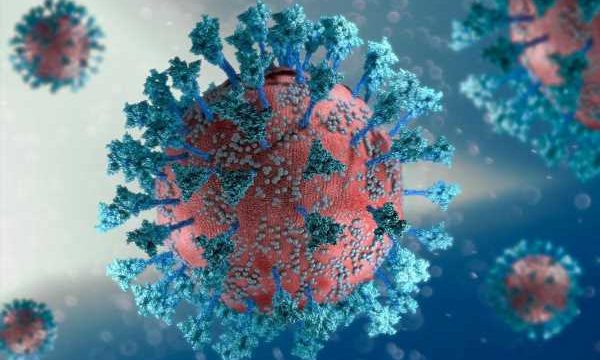Several mutations in the severe acute respiratory syndrome coronavirus 2 (SARS-CoV-2) Omicron spike protein cause additional positive surface charges compared to the reference spike protein (from the original strain that emerged in Wuhan) in the receptor-binding motif (RBM), including N440K, T478K, Q493R, Q498R and Y505H.
This has functional implications as the electrostatic charge can alter both the tertiary structure of the protein and its ability to bind the angiotensin-converting enzyme 2 (ACE2) receptor.
 Study: Omicron Spike protein has a positive electrostatic surface that promotes ACE2 recognition and antibody escape. Image Credit: Naeblys/Shutterstock
Study: Omicron Spike protein has a positive electrostatic surface that promotes ACE2 recognition and antibody escape. Image Credit: Naeblys/Shutterstock
Researchers from New York University have been examining the effect of these electrostatic changes on the ability of Omicron to escape immunity, and their results have been posted on the bioRxiv* preprint server, whilst the article undergoes peer review.
The study
The researchers quantified the electrostatic interactions between the receptor-binding domain (RBD) and hACE2 by computing the electrostatic binding energy as a function of separation distance for reference, using both the Delta and Omicron spike proteins. The energies were computed at 150mM monovalent ions to simulate physiological conditions.
The results showed that the Omicron RBD has a greater affinity for ACE2 compared to both the reference spike protein and the Delta strain, and this remained true over all distances. Omicron’s electrostatic energies are three to nine times greater than the reference RBD and 3-5 times greater than the Delta RBD over the separation distances when compared and remains influenced by the negatively attractive electrostatic force emanating from ACE2 even at the greatest distance tested. The scientists also suggest that if the full trimer was used, instead of just the RBD, this attraction would be even greater. Of course, this would likely be true for the reference and Delta strains as well.
The scientists then analyzed RBM mutations, charges and electrostatic surfaces across SARS-CoV-2 phylogenies, to better understand if the increase in positive surface charge was a driver of viral evolution. They superimposed information about the electrostatic surfaces on the phylogeny of variants as a function of viral emergence in order to reveal biological relationships. This revealed a gradual accumulation of positive charges in the RBD over time, with related clades showing similar electrostatic surfaces. Between the beginning of the pandemic and the autumn of 2020, the Alpha Beta, Epsilon and Lambda variants all acquired a moderate increase in positive surface charges, around one elementary electric charge.
After this time, the accumulation became more significant, with the Gamma, Delta, Eta, Iota, Kappa and Mu variants all showing greater increases – two elementary electric charges. The most recent changes in the Omicron variant appear to continue this trend to an even greater extent, gaining 5 elementary electric charges.
Following this, the researchers selected six representative antibodies that bind to different sites on the RBD and attempted to assess the response of these antibodies to Omicron. The spike-interacting interfaces of all six antibodies were predominantly positively charged, with only S2X259 showing a negatively charged interaction interface. It is also the only antibody to bind outside of the RBM. The increased positive charge of the Omicron RBD is therefore likely to be a factor in its increased resistance to most classes of antibodies.
Computational modeling was then used to directly quantify the effects of these mutations. The previous six antibodies were used, and mutations were considered in direct contact with antibodies. The strength of antibody escape was defined as normalized affinity change. The antibody escape scores showed the most prominent peaks across all antibodies came from confirmed escape mutations E484K/Q, found in n Beta, Gamma, Zeta, and Kappa variants. N501Y showed moderate escape, as did K417N/T, but only against certain antibodies. The L425Q mutation found in Delta could escape every antibody except S2X259, and T487K also showed significant antibody evasion ability.
Finally, the researchers used computational modeling to identify antibody escape in the Omicron variant. They examined the major energy components contributing to binding affinity and computed the escape scores for each energy component. They observed similar patterns of antibody affinity destabilization to the electrostatic energy component, with most antibodies other than S2X259 unfavorably affected. Further analysis of Omicron mutations’ contribution to antibody escape showed that almost all individual Omicron mutations could escape some antibodies.
Conclusion
The authors have shown that the spike protein RBD has been gradually adapting over the course of the pandemic to a more positively charged state, increasing its affinity for ACE2 while simultaneously reducing the ability of antibodies to neutralize it.
The computational models helped show which antibodies are likely to be affected by this, and which mutations contribute. This could be very informative for those seeking to create monoclonal antibody treatments for Omicron and might affect future vaccine development.
*Important notice
bioRxiv publishes preliminary scientific reports that are not peer-reviewed and, therefore, should not be regarded as conclusive, guide clinical practice/health-related behavior, or treated as established information.
- Hin Hark Gan, John Zinno, Fabio Piano, Kris Gunsalus. (2022). Omicron Spike protein has a positive electrostatic surface that promotes ACE2 recognition and antibody escape. bioRxiv. doi: https://doi.org/10.1101/2022.02.13.480261 https://www.biorxiv.org/content/10.1101/2022.02.13.480261v1
Posted in: Medical Research News | Medical Condition News | Disease/Infection News
Tags: ACE2, Angiotensin, Angiotensin-Converting Enzyme 2, Antibodies, Antibody, binding affinity, Computational Modeling, Coronavirus, Coronavirus Disease COVID-19, Enzyme, Evolution, immunity, Monoclonal Antibody, Mutation, Omicron, Pandemic, Phylogeny, Protein, Receptor, Respiratory, SARS, SARS-CoV-2, Severe Acute Respiratory, Severe Acute Respiratory Syndrome, Spike Protein, Syndrome, Vaccine

Written by
Sam Hancock
Sam completed his MSci in Genetics at the University of Nottingham in 2019, fuelled initially by an interest in genetic ageing. As part of his degree, he also investigated the role of rnh genes in originless replication in archaea.
Source: Read Full Article
